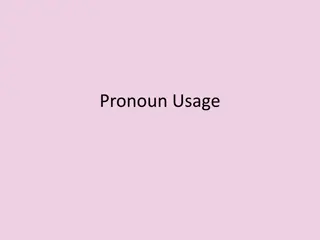Latin Grammar Songs and Chants for Learning Cases
Explore catchy tunes teaching Latin grammar cases - Nominative, Genitive, Dative, Accusative, and Ablative, along with 1st and 2nd Declension songs. Engage in a fun and educational way to understand these essential concepts through music!
1 views • 10 slides
Understanding Pronoun Case: Nominative and Objective Pronouns
We have covered all pronouns in the slide show but still need to discuss pronoun case. Personal pronouns have nominative and objective cases. Nominative pronouns like "I" are used as subjects, while objective pronouns like "me" are used as objects. Learn how to use them correctly in sentences with e
0 views • 11 slides
Understanding Syntactic Transitivity in Estonian Language
This presentation by Natalia Vaiss from Tallinn University delves into the intricate details of syntactic transitivity types and the usage of direct objects, particularly focusing on partitive-accusative alternations in the Estonian language. It explores the morphological aspects of genitive and nom
0 views • 41 slides
Understanding Greek Noun Inflection and Cases
Explore the intricacies of Greek noun inflection, including cases like nominative, subjective, genitive, possessive, dative, and accusative. Learn about lexical forms, gender, number, and how to identify cases in Greek nouns. Dive into examples from John 3:16 and Mark 2:2 to see these concepts in ac
0 views • 36 slides
Understanding Latin Noun Cases and Declensions
Explore the use and distinctions of Latin noun cases (Nominative, Genitive, Dative, Accusative, Ablative), along with the concept of declensions, genders, numbers, and cases. Learn how to determine the declension, gender, number, and case of a Latin noun through its endings, and delve into examples
0 views • 23 slides
Latin III Exam and Grammar Overview
This Latin III exam study guide covers various grammar topics including nouns, predicate nominative with passive verbs, possessive quantity partitive, special uses of dative and ablative cases, locative case, pronouns, positive comparative superlative forms, and correlatives. The guide provides expl
0 views • 26 slides





